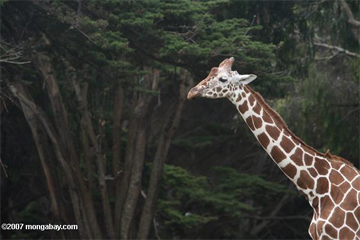Past climate change drove mass extinction in Pakistan
Jeremy Hance, mongabay.com, September 26, 2008
Past climate change cut mammal biodiversity by over half in lost ecosystem
Research on long-vanished mammals in the Siwalik region of Northern Pakistan has yielded results relevant for today. In the span of two-and-a-half million years climate change caused a shift in Siwalik habitat from wet monsoon forest to savannah, dooming over half the mammal species to local extinction. The research was published by the Proceedings of the National Academy of Sciences.
Eight-and-a-half million years ago during the Miocene the Siwalik region was rich in mammal diversity. Findings include two giraffe species, five elephant-relatives, a hominid, horses, rhinos, antelope, mouse deer, bush pigs, and rodents. Although unlike any contemporary ecosystem surviving, it probably most resembled a cross-between Africa's tropical forest and savannah.
The massive climate shift caused the ecosystem's vegetation to change from broad-leaf plants and fruits to grasses. Studying the chemistry and wear of the tooth enamel of various herbivore specimens, researchers reconstructed how the changing ecosystem affected individual species. Some were able to adapt to the new dietary changes; others disappeared.
Mammals dependent on fruit were the first casualty at Siwalik. As soon as forests—and their fruit—disappeared these species vanished and were not replaced. Examples include a hominoid, two large pig-like species, four mouse deer species, and a hippo-like animal.
Modern-day giraffe
Mammals that lived off leaves and grass either adapted their diet to more grass, or were driven out. New immigrants, suited to the emerging savannah, colonized the new ecosystem.
"We see quite a different ecological profile of the kinds of mammals that coexisted after this climate change than before," said lead author Catherine Badgleys, an assistant professor of ecology and evolutionary biology at the University of Michigan. "It's clear that climate has had an impact on the ecological diversity of mammals in the area."
Such discoveries could only happen in a place like Siwalik. The sediments in Siwalik contain a two mile thick rock deposit with mammal specimens from 18 to 1 million years ago. It is the longest and best record of land-dwelling mammals. For their research, Badgley and her fellow researchers poured over 18,000 fossils representing 150 mammal lineages, or species descended from a common ancestor.
Badgely believes the research has relevance to contemporary climate change. "Climate is going to produce changes in ecological structure of all sorts of plants and animals around the world, now as in the past,” Badgley said. “The fossil record can help us understand how much—or how little—climate change is necessary to produce changes in ecosystems.”
For those who believe climate change may transform our existing forests into savannas the prognosis for biodiversity is grim.
Catherine Badgley, John C. Barry, Michele E. Morgan, Sherry V. Nelson, Anna K. Behrensmeyer, Thure E. Cerling, and David Pilbeam. Ecological changes in Miocene mammalian record show impact of prolonged climatic forcing. PNAS Online Early Edition August 18th, 2008.











No comments:
Post a Comment